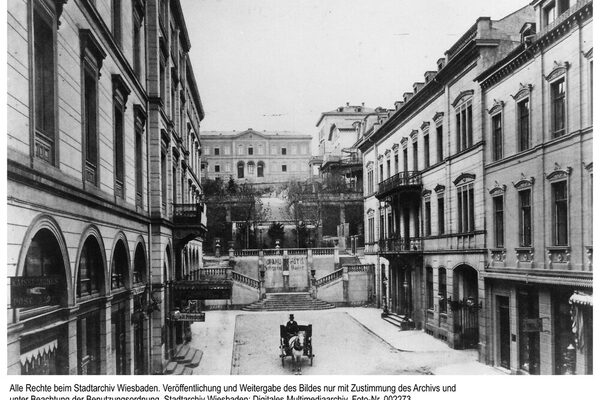Schützenhof
The Schützenhof estate with its associated bathhouse and its own thermal spring passed to the Schütz von Holzhausen family in 1572, from whom the name derives, and in 1631 to the Counts of Nassau, who owned the "Grafenbad" for around 80 years.
In the 18th century, the Schützenhof had several owners until Reinhard Kässberger, the landlord of the "Zum Einhorn" bathhouse, acquired it in 1783. He had a three-winged complex built by 1795, the façade of which extended from Gemeindebadgässchen to Schützenhofstraße, which did not yet exist at the time, and was almost 90 m long. Behind it, the grounds, consisting of vineyards and gardens, stretched up to the Schulberg. The main attraction was a large hall with around 300 seats, which Kässberger regularly rented out to passing theater troupes from 1801 onwards. In 1847, the ducal domain administration purchased the building complex, initially with the plan to build a new hospital on the site. However, this project could not be realized. For a number of years, the Schützenhof now served as a court and court of appeal as well as alternative accommodation for the grammar school.
In 1864, it was sold again to several financiers, who had the old Schützenhof demolished. The old garden was replaced by the lower Schützenhofstraße with a staircase to the Schulberg, to the left of which was the new "Grandhotel Schützenhof" and opposite a post office building. Plots for eight houses with stores were divided up along Langgasse. Above a garden terrace framed by arcades and pergolas, with flowerbeds, fountains and candelabras, building plots for country houses were laid out up to the Schulberg. The Grand Hotel with the Schützenhof spring, inaugurated in May 1869, never got out of the red. The town finally bought the establishment in 1879.
After the decline of the spa as a result of the First World War and the subsequent period of occupation, the Schützenhof was temporarily used as a retirement home. Severely damaged during the Second World War, it housed a branch of the municipal library and the municipal archive after 1945.
In the 1950s, the Schützenhof was home to a rheumatism clinic before the building finally fell victim to the pickaxe in 1969.
Literature
Collection of newspaper clippings from the Wiesbaden City Archives, "Schützenhof".
- Renkhoff, Otto
Wiesbaden in the Middle Ages. History of the City of Wiesbaden 2, Wiesbaden 1980.
- Struck, Wolf-Heino
Wiesbaden in the Biedermeier period (1818-1866). History of the City of Wiesbaden 5, Wiesbaden 1981.
